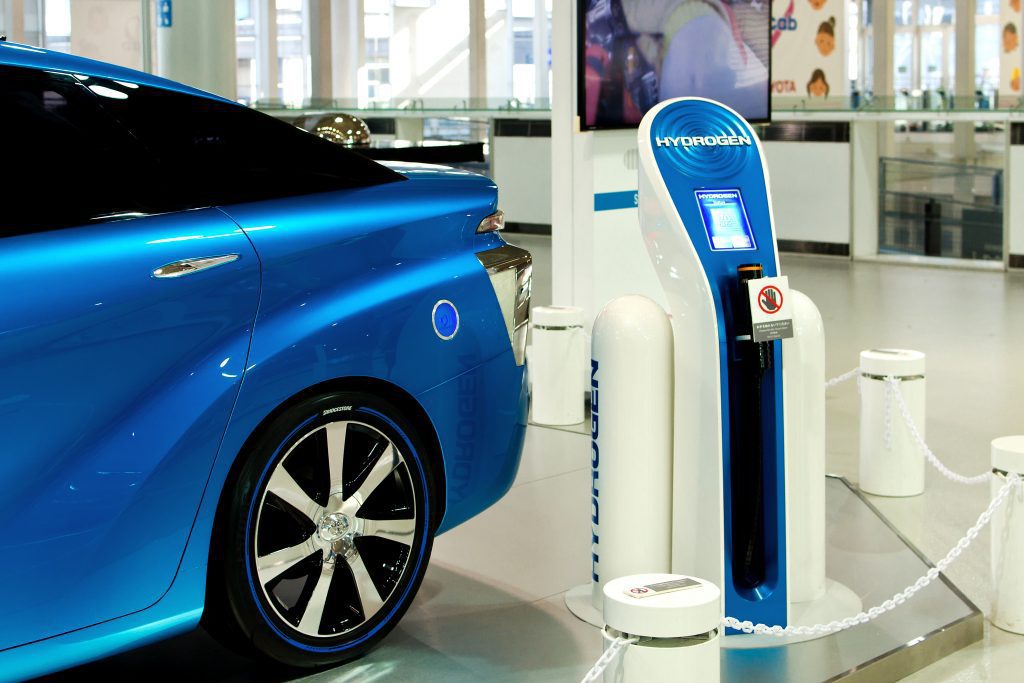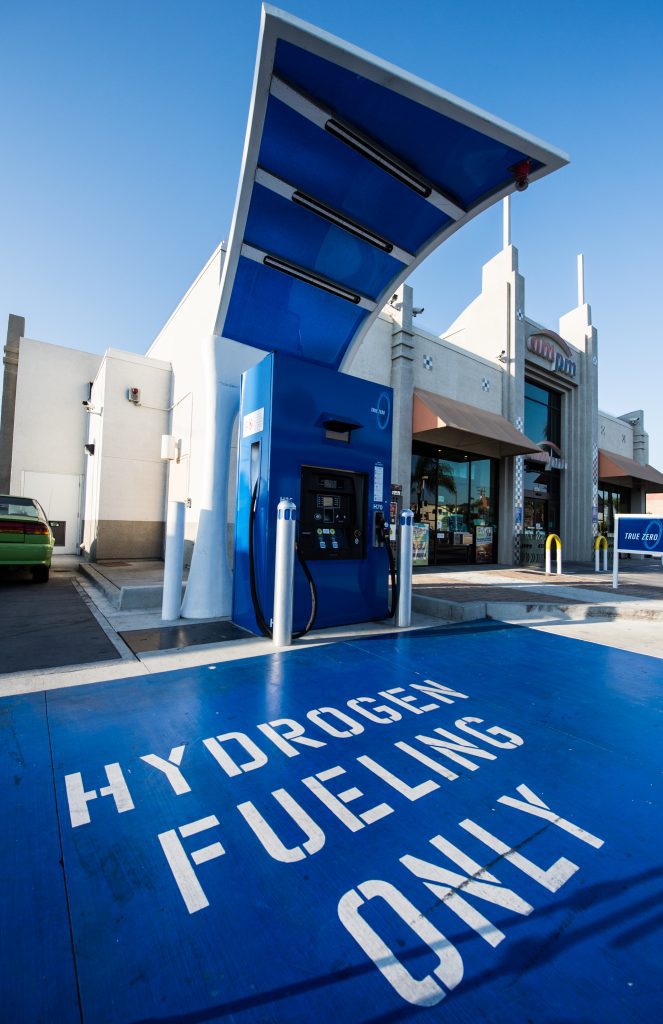As the demand for hydrogen fuel starts to grow, the federal and Alberta governments are poised to make critical decisions about the future shape of Canada’s role in the emerging hydrogen economy. Will these decisions commit us to large subsidies to a new and unproven fossil fuel technology or jump start a new industry aligned with a carbon free future?

First, some information about the advantages and disadvantages of hydrogen fuel
HYDROGEN FUEL: THE ADVANTAGES
Hydrogen is the perfect transportation fuel in many ways. It can be compressed into a liquid and stored in tanks like propane. When it is burned it produces only water – no polluting carbon or nitrogen emissions at all. In addition, recent advances in fuel cell technology, many by Canadian companies, mean that this “burning” can be done in a controlled manner using a catalyst, producing electricity, water and some heat. This means that vehicles fueled by hydrogen can be reliable, efficient electric powered vehicles instead of being equipped with carbon spewing internal combustion engines. Also hydrogen’s ability to be stored in fuel tanks means it can be stored in “gas stations” and provide for fast refueling (3-4 minutes), a key advantage over battery powered electric vehicles at this time (charging time of 30 minutes to 12 hours).
Possible applications are extensive and include stationary power, trains, transport trucks, passenger vehicles and boats. It can also play an important role in providing a powerful energy source for hard-to-decarbonize sectors like steel and cement.
HYDROGEN FUEL: THE DISADVANTAGES
There are some disadvantages that help to explain the lack of hydrogen’s use to date. Most are related in some way to cost. Hydrogen is the very smallest of molecules and that means that pipes and fuel tanks have to be able to withstand very high pressures and be welded in a manner that does not allow the hydrogen to escape. These pipes and tanks are more expensive to build and maintain and contribute to each hydrogen fueling station costing between $1 and $2 million. As a result there are currently only two public hydrogen fueling stations in Canada, located in Vancouver and Quebec City.
Fuel cells themselves have been expensive and challenging to produce in a portable enough form to fit in a car or a truck. This has made them more expensive than battery powered electric vehicles (approximately three times as expensive, currently).

THREE TYPES OF HYDROGEN
As the push for economy-wide electrification grows due to climate change there is a growing focus on the increased use of hydrogen.Canada could and should be a leader in this effort. The question is what kind of hydrogen will we focus on?
There are three “types” of hydrogen which are named based on the source of the energy from which they are produced. These are discussed below in the order of most carbon intensive to least.
GREY HYDROGEN (sometimes called Brown Hydrogen)
“Grey” hydrogen is created by breaking down fossil fuels and releasing the carbon dioxide into the air. This process is called steam reformation and uses natural gas, partial oxidation of methane or coal gasification. It is the dominant mechanism used to produce hydrogen today (95% of global production). These processes contribute to climate change and cannot be considered a clean fuel overall, despite the fact that the hydrogen produced is carbon-free when it is consumed in vehicles etc.
BLUE HYDROGEN
“Blue” hydrogen is an evolution of fossil fuel-based processes where natural gas is used as the source fuel but most, but not all, of the carbon dioxide is captured during methane production. This carbon dioxide must then be stored underground to keep it out of the atmosphere. This is called carbon capture and storage (CCS).
GREEN HYDROGEN
“Green” hydrogen is made by using electricity to split a water molecule into hydrogen and oxygen. This is called “electrolysis”. The electricity source can be from solar, wind or hydro power and can be carried out when there is excess electricity available, such as on a windy night near a wind farm. This can then be a mechanism for “storing” this surplus energy. Only about 4% of the hydrogen produced globally is currently produced using electrolysis.
FOSSIL FUEL COMPANIES ARE PUSHING BLUE HYDROGEN
Fossil fuel companies, and some policy makers, are pushing Canadian governments to invest in fossil fuel derived “blue” hydrogen. They argue that this will help establish hydrogen infrastructure and allow for an ultimate transition to green hydrogen at some later date.
Critics point out the multiple weaknesses of this argument including that fossil fuel derived hydrogen requires the construction of hydrogen, methane, and CO2 pipelines, still releases some CO2 and methane into the atmosphere and is hindered by the fact that the only commercial application for using captured CO2 is improving the efficiency of oil wells, which in turn creates more CO2. By contrast , green hydrogen can be produced at the source of the surplus electricity, requires no pipelines and produces not a gram of carbon emissions.

CANADA SHOULD INVEST IN GREEN HYDROGEN
Of course, another challenge is that we don’t have time for a “later” transition to green hydrogen. Climate change impacts are mounting at such a rate that all new government investments must be focused on rapid transition to carbon-free energy systems. In addition, the economic crisis created by COVID-19 means that the ability of governments to invest “later” in green hydrogen is likely to be severely compromised. If they push out massive subsidies to fossil fuel based blue hydrogen now, there will be nothing left for investment in green “later”. Canadian governments need to consider this reality as they actively consider the form that their hydrogen strategies will take.
The stakes are high as fossil fuel companies are pushing hard for government subsidies for blue hydrogen. They are doing this in a similar manner where they successfully secured massive subsidies for CCS for coal plants by luring in politicians who wanted to believe that coal plants could operate economically while ceasing to emit carbon dioxide, and thus allowing the politicians to avoid having to close these plants. This turned out to be impossible. So it is with a great sense of deja vu that we see a failing fossil fuel industry desperately searching for a new lifeboat to prop up demand.
Blue hydrogen faces real challenges in terms of practicality, polluting emissions and price. It is also facing competition from green hydrogen which has none of the first two issues and is gaining quickly on the third. The prices of renewable energy sources that power green hydrogen are falling precipitously and are the lowest cost sources of new power in many parts of the world. Investment is also climbing with global production growing by 230% between 2000 and 2018. The creation of electrolysis-derived hydrogen provides a ready mechanism to allow for more rapid expansion of renewable energy. This is because excess power can be used to produce hydrogen and this hydrogen can then be converted back to electricity in times of increased need. It therefore can act as a grid scale storage mechanism as well as a fuel for transportation and industry.
The federal and Canadian governments should think carefully, do their homework and consult with other leading jurisdictions before making major spending decisions on the new hydrogen economy. We will only get one chance to kick start innovation and investment in the right direction. We need to remember that our governments have committed to net-zero emissions by 2050, so if “blue” hydrogen is not net zero, why use taxpayers money to subsidize a technology that distracts from achieving that goal and puts us offside with where the new hydrogen economy is headed?
Stay up-to-date on environmental issues. Join our email community.









